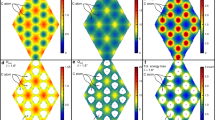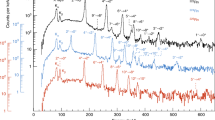Abstract
THE most direct way by which an ion can be displaced in an ionic lattice when the lattice is subjected to ionizing radiation is through simple collision displacements. Thus high-energy electrons can be expected to produce displacements by simple ‘billiard-ball’ collision; γ-rays can possibly produce displacements by Compton scattering, either by direct recoil of the ions or by producing high-energy electrons which afterwards collide with and displace ions.
This is a preview of subscription content, access via your institution
Access options
Subscribe to this journal
Receive 51 print issues and online access
$199.00 per year
only $3.90 per issue
Buy this article
- Purchase on Springer Link
- Instant access to full article PDF
Prices may be subject to local taxes which are calculated during checkout
Similar content being viewed by others
References
Massey, H. S. W., and Burhop, E. H. S., “Electronic and Ionic Impact Phenomena”.
Westervelt, D. R., “Mechanical Effects of Ionising Radiation in the Alkali Halides”, NAA-SR-888.
Author information
Authors and Affiliations
Rights and permissions
About this article
Cite this article
VARLEY, J. A Mechanism for the Displacement of Ions in an Ionic Lattice. Nature 174, 886–887 (1954). https://doi.org/10.1038/174886a0
Issue Date:
DOI: https://doi.org/10.1038/174886a0
This article is cited by
-
Effect of gamma-irradiation on the thermal decomposition of barium oxalate hemihydrate
Journal of Radioanalytical and Nuclear Chemistry Articles (1994)
-
Effect of temperature and60Co γ-radiation damage on the electrical and structural properties of BaZrO3 ceramics
Journal of Thermal Analysis (1985)
-
Solid state nuclear track detectors
Journal of Materials Science (1980)
-
Degradation of light-emitting diodes (Review)
Journal of Applied Spectroscopy (1980)
Comments
By submitting a comment you agree to abide by our Terms and Community Guidelines. If you find something abusive or that does not comply with our terms or guidelines please flag it as inappropriate.



